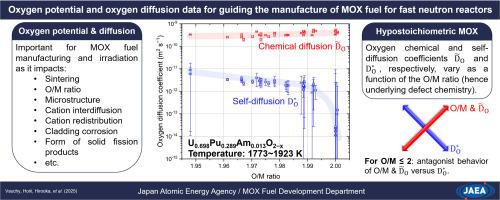指导快中子堆MOX燃料制造的氧势和氧扩散数据
IF 3.2
2区 工程技术
Q3 MATERIALS SCIENCE, MULTIDISCIPLINARY
引用次数: 0
摘要
在铀-钚混合氧化物燃料烧结过程中,控制氧/金属比是一项战略任务,特别是对快中子反应堆而言。在了解MOX烧结过程中还原的框架下,用热重法在1773 ~ 1923 K范围内测定了u0.698 pu0.283 am0.013 o2−x在细长柱状致密球团上的氧势和氧化学扩散系数。开发了一种创新的实验方案,将氧化学扩散与氧/金属比范围联系起来,从而与潜在的缺陷化学联系起来。将氧化学扩散系数与缺陷化学相结合,得到了氧自扩散系数。这些新数据有助于更好地理解MOX作为快中子反应堆燃料制造过程中的还原机理和动力学。本文章由计算机程序翻译,如有差异,请以英文原文为准。

Oxygen potential and oxygen diffusion data for guiding the manufacture of MOX fuel for fast neutron reactors
Controlling the Oxygen/Metal ratio during the sintering of uranium−plutonium mixed oxide fuels is strategic, especially for fast neutron reactors. Within the frame of understanding the reduction of MOX during its sintering, new oxygen potential data and oxygen chemical diffusion coefficients of U0.698Pu0.289Am0.013O2−x were determined by thermogravimetry between 1773 and 1923 K on elongated cylindrical dense pellets. An innovative experimental protocol was developed to correlate oxygen chemical diffusion to Oxygen/Metal ratio ranges, and thus to the underlying defect chemistry. Oxygen self-diffusion coefficients were also obtained by combining the oxygen chemical diffusion coefficients with defect chemistry. These new data provide a better understanding of the mechanisms and kinetics of MOX reduction during its manufacturing as a fast neutron reactor fuel.
求助全文
通过发布文献求助,成功后即可免费获取论文全文。
去求助
来源期刊

Journal of Nuclear Materials
工程技术-材料科学:综合
CiteScore
5.70
自引率
25.80%
发文量
601
审稿时长
63 days
期刊介绍:
The Journal of Nuclear Materials publishes high quality papers in materials research for nuclear applications, primarily fission reactors, fusion reactors, and similar environments including radiation areas of charged particle accelerators. Both original research and critical review papers covering experimental, theoretical, and computational aspects of either fundamental or applied nature are welcome.
The breadth of the field is such that a wide range of processes and properties in the field of materials science and engineering is of interest to the readership, spanning atom-scale processes, microstructures, thermodynamics, mechanical properties, physical properties, and corrosion, for example.
Topics covered by JNM
Fission reactor materials, including fuels, cladding, core structures, pressure vessels, coolant interactions with materials, moderator and control components, fission product behavior.
Materials aspects of the entire fuel cycle.
Materials aspects of the actinides and their compounds.
Performance of nuclear waste materials; materials aspects of the immobilization of wastes.
Fusion reactor materials, including first walls, blankets, insulators and magnets.
Neutron and charged particle radiation effects in materials, including defects, transmutations, microstructures, phase changes and macroscopic properties.
Interaction of plasmas, ion beams, electron beams and electromagnetic radiation with materials relevant to nuclear systems.
 求助内容:
求助内容: 应助结果提醒方式:
应助结果提醒方式:


